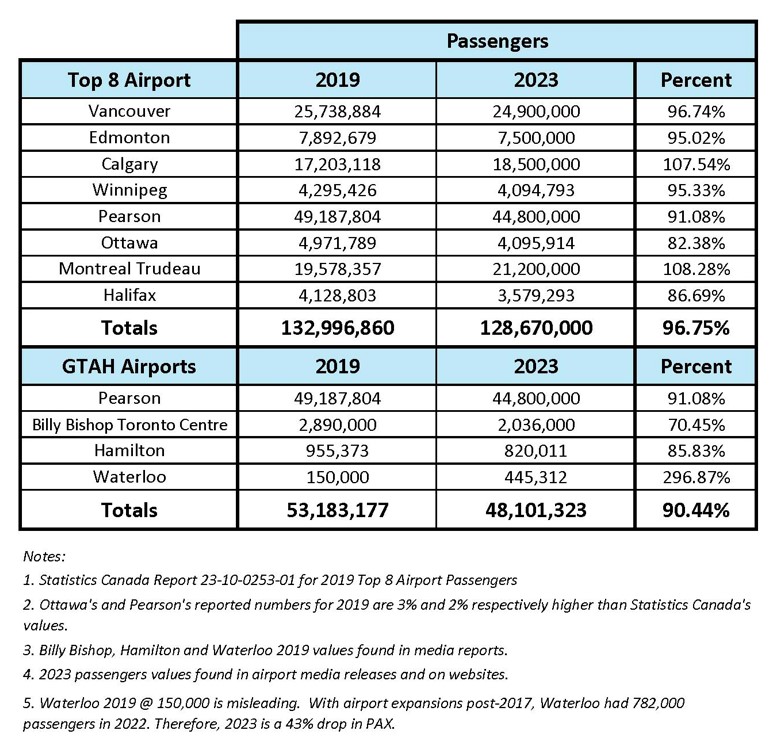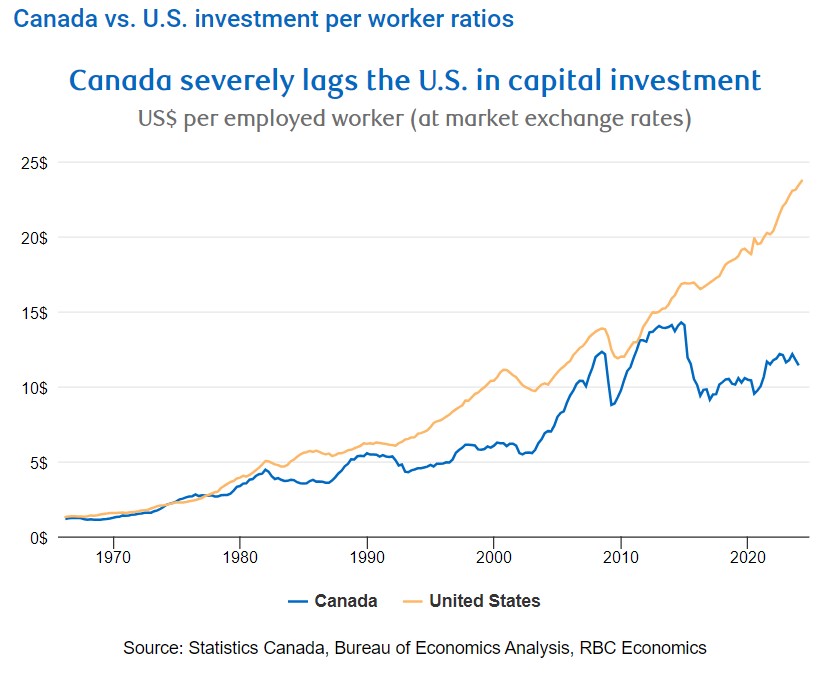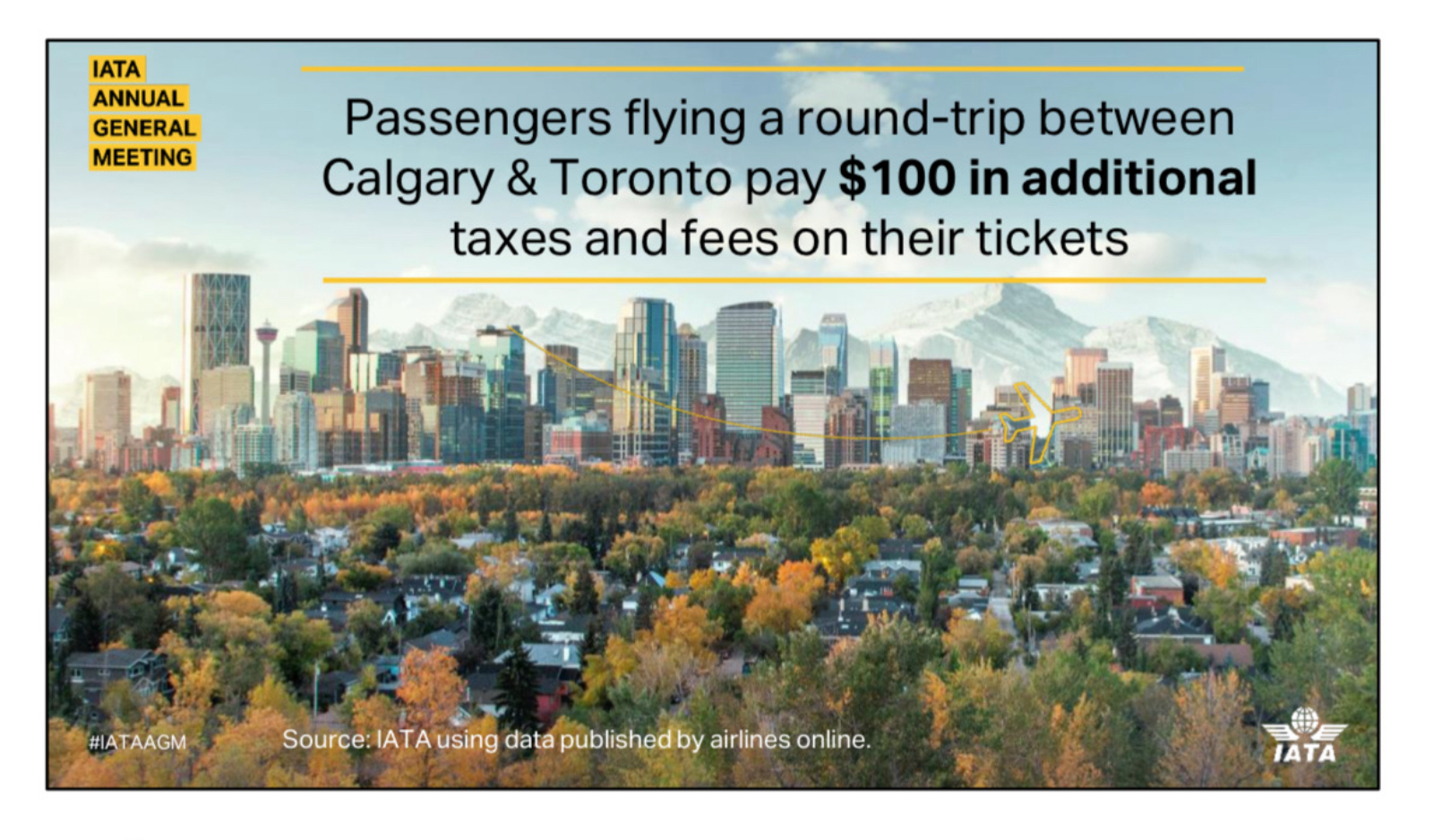By Ted Nickerson
Back in March 2023, I posted my “Final” update to passenger recovery post-COVID. Well, I couldn’t let it go and have discovered some surprising insights that everyone needs to hear.
Here is a June 2024 snapshot (a snapshot since Statistics Canada, a key credible data source, has not released the 2023 Canadian air traffic numbers). It contains an ominous break with our key trading partners.
Previously, IATA had forecasted that North America air traffic would reach 102% of the 2019 level –Full Recover Plus. In fact, the USA ended 2023 at 101.7%, and Mexico reached an astonishing 118.6% of their respective 2019 levels.
Canada, using CATSA Screened Passenger data, reached 97.4%, sure somewhat short of the IATA forecast, and lagging USA and Mexico but still a substantial 22.8% growth from 2022
And then on March 29th, the GTAA reported that Toronto Pearson ended 2023 at 88.9% of its 2019 traffic volume. The airport that makes up about 30% of total national air traffic is 9% lower than my analysis for 2023! Is my analysis for 2023, right?
Turns out, it is!
In the following table, the 2019 Top 8 Airports air traffic values are from Statistics Canada. The other values are from 2024 airport media releases or their websites. I will have to wait for Statistics Canada 2024 update to cross-check and confirm the numbers.

So, my CATSA-based analysis indicates 97.4%, and the new analysis shows 96.5%, close enough for now. Only Calgary and Montreal Trudeau airports finished 2023 well above their 2019 traffic volumes.
Nationally, Canada is lagging behind its North American partners at least in part because of the GTHA (Greater Toronto and Hamilton Area) performance. Why is this happening locally and what does it signal nationally?
It’s the Economy Stupid!
For 2024, GDP growth is forecasted to be 2.2% in Mexico and 2.5% in the USA, but that’s 3 to 4 times greater than forecasted for Canada at just 0.7%.
Unfortunately, this is not a new or unknown problem for Canada. This is indicative of decades-long structural problems in how Canada is governed.

No surprises here! Just look at what’s happened in the last year. Huge increases in food prices, housing affordability issues and relentless tax increases. Small businesses, the creators of countless jobs, are failing with business bankruptcies at a 10-year high. And unless you are employed in the public sector, wages haven’t moved much in the last couple of years either. Lack of new capital investments by businesses and government in comparison to the US is one factor.

There are no quick fixes here. Canada’s economy is severely lagging behind its neighbours and other advanced economies. Our standard of living is dropping. The Toronto area’s soaring cost of living and small business bankruptcies are examples of Canada’s economic challenges.
This is not just an aviation problem, but national economic issues have become manifested in the aviation industry.
For example:
Airport Congestion:
New investments in aviation infrastructure almost stopped during COVID. In the US, airports received Billions of dollars in new government capital investments, taking advantage of the downtime to repair or build new infrastructure. Canadian airports received no such government support.
The commercial passenger load factor jumped up to 87% in 2023 from the previous decade’s average of 83% (COVID period excluded). Simply more people on the planes, so why don’t they add more planes? Because through COVID, the Canadian industry lost pilots, mechanics, airport and ATC (Air Traffic Control) staff. Staffing levels have not yet returned to the pre-COVID levels.
Nav Canada, the Not-for-Profit company that runs Canadian ATC, laid off hundreds of hard-to-replace specialists. Canada’s busiest most congested airport, Toronto Pearson, has been especially hard hit by this loss.
The other key loss has been pilots. Some retired, while others went to the US or overseas and are now earning more money than they can in Canada. The interruption of and lack of support for flight training schools during COVID created a notable gap in new pilots able to replace those lost. The result, Toronto Pearson became the worst on-time performance airport in North America and a drag on the airlines utilizing it. Air Canada, Canada’s biggest carrier, landed 63% of its flights on time in 2023.
In response to these new capacity constraints, airlines have moved some operations out of Toronto Pearson to locations where capacity existed. Air Canada shifted what it could to Montreal and West Jet retreated to Calgary.
Notably, the one thing Canada’s two 2023 aviation bright spots (Calgary and Montreal) have in common is available airport capacity. Both cities host a growing aviation manufacturing industry with dramatically low-cost aviation services, unlike the Toronto area.
Aviation Costs Are Rising:
During COVID, Canada’s federal government provided little support for any part of the aviation industry. It only grudgingly provided a fraction of the level of industry support provided to the American industry and then, only near the end of the pandemic. Even the GTAA (Greater Toronto Airport Authority) which runs Pearson Airport, was forced to take on hundreds of millions in additional loans to cover its losses.
Worldwide jet fuel costs are high. Air Canada pilots are demanding huge wage increases. The government continues to see the industry as a revenue source, taxing jet fuel, tickets, and property, rather than seeing airports as critical economic engines.

For instance, per IATA, there is $140 CDN in government taxes included in a ticket from Calgary to Toronto. Low-cost carriers in Canada can’t sell tickets at the higher prices created by taxes and go under.
Passenger Growth in Canada is Lagging its North American Partners
IATA, at its annual General Meeting, forecasted that North American passenger volumes would grow by 6.3% Year-over-Year in 2024. Based on Screened Passengers CATSA year-to-date data (through June 16th), passenger volumes at the Top 8 Canadian airports (about 88% of the industry) have grown by just 1.7% over the 2023 value.
Sorry, there is no way the math works for Canada’s aviation passenger sector to be up 6.3% by year-end 2024! The industry will have to grow 4-6 times faster in the second half of 2024 than it did in the first half. Canada in general and the Toronto Area specifically does not have the skilled workforce or infrastructure to grow this quickly.
The break with other G7 economies is dramatic and can be traced to the actions and inactions of Canada’s federal Governments (both current and previous).
I am confident that airlines and airport authorities will do whatever they can to improve their performance and support continued commercial aviation growth in Canada. Unfortunately, the big economic levers are beyond their control.
Canadians like to travel but it’s becoming too difficult and too expensive. Job creators, like businesses both big and small, need reliable, accessible aviation transportation to grow and to be competitive.
Canada’s economy needs breakout productivity and GDP growth.
From the aviation perspective, our government needs to change how it views the industry including its airports. Stop seeing the industry as a cash cow. Stop taxing it and instead start supporting it. Help it grow.
Airports are economic engines. They create wealth and jobs well beyond their boundaries, nationally, regionally and in local communities.
I would be remiss if I didn’t mention Pickering Airport in this context. Its delay is an example of the governments’ intransigence and lack of vision. An example of how the federal government is failing to support and advance economic growth in Durham Region specifically and throughout the Greater Toronto Area in general.
References:
Air Canada lands last in on-time flights in ranking of North American airlines | CBC News
Canada’s Growth Challenge: Why the economy is stuck in neutral – RBC Thought Leadership
IATA Annual General Meeting – State of the Americas
You got climate religion on the Left, and farmland worship on the Right. And the opponents of the airport shift between these arguments depending on who is in power.
Canada is the 2nd largest landmass in the world with less than 3% developed of any kind. It has 165 million acres of farm, or 4.1 acre/person, the highest in the world. Not just the airport, but every time a project is to happen, the same 100 geriatric members of the 10 anti-development groups show up to cry that farmland is precious and we would all go hungry now, or that the planet would “boil” over whatever that’s to be built – airport, highway, homes, even hospital. It’s time people show to these meetings and call out this gaslighting to their lying faces. They have truly hurt this country, its economy and future. Canada’s GDP per capita has been and is failing fast compared to peers. Canada is not an agrarian society in which farmland must trump all other needs. Canada is a G7 nation, supposedly an industrialized economy but lately doesn’t act that way at all.
You have the problem. You fail on the solution.
And
Toronto debt.. Yup..they spent 500 million dollars on land east of the airport in 2017 that they will not account for .and is doing nothing . Read their annual reports on Malton Gateway Corp.
To plan GTAA need to be able to forecast. And they can’t. Why? Riddle that.
read the post properly before espousing nonsensical comments.
Envision Durham has been on hold with the province since May 17, 2023. The MZO request by Kevin Ashe last months was to remove the airport restriction so Envision Durham could move forward. But after being lobbied by anti-development groups, a memo came in from the Feds to put Envision Durham on hold, guess for what? For the airport ! But not that they are going to build the airport, but only to use the idea to hold other things from being built. The same eco-psychopaths like Maurice Brenner who fought the idea of the airport so tooth and nail, now use the idea of the airport to lobby against building anything else around there! Unfortunately, there is no one to call out these people’s intellectual dishonesty to their faces, so they continue to lie.
Nothing gets built in this country. Eco-radicals and gatekeepers have paralyzed Canada from all sides. The below is one giant example people should know about:
Federal gov expropriated 20,000 acres of land in Pickering 54 years ago to build an airport. It was never built because of eco-radicals protesting. Instead the land has been rented to a few insider commercial farmers at no rent and no tax for their private profit. They have a lobby group named “land over landings” that cooked a deal with local MP Jenn O’Connell to get 10-year leases instead of 1-year.
Then, urged by the lobby group, the eco-radicals in Pickering council such as Maurice Brenner voted against the mayor to say no to an airport last year, to keep the lands in limbo, even though it’s not even their jurisdiction.
But it gets worse. Last year, the region decided to add 7000 acres to the urban boundary for homes, on lands near that airport site. Then the same eco-radicals against the airport, lobbied the federal gov to put a stop to that, get this, on the basis of an airport !!! So the same radicals who opposed the airport now using the idea of the airport not to let any homes be built around there !!!